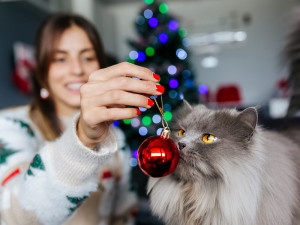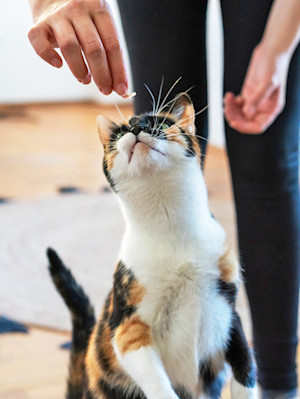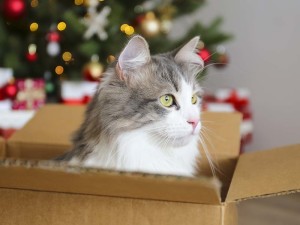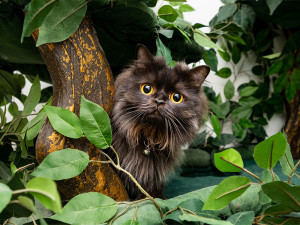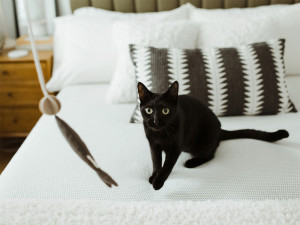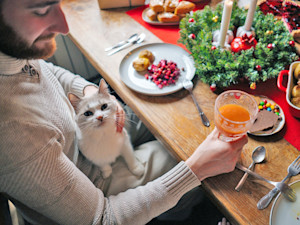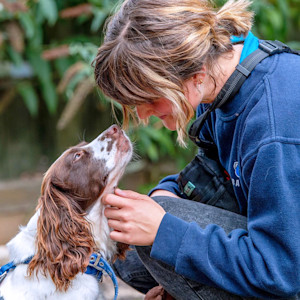How To Support Your Cat Emotionally Over the Holidays
It’s the most wonderful time of the year... for you. Your cat feels otherwise
A tree strung with twinkling lights, the family gathered to exchange gifts and play games while a cat dozes in front of the stocking-hung fireplace – it’s a quintessential festive scene.
The festive season may be filled with sparkle and joy, but also, let’s be honest, a fair bit of chaos. And so in many households, you’re more likely to find the resident cat hiding under a bed or scarpering out through the cat flap into the cold as soon as guests or carol singers ring the doorbell.
As Christmas, Hanukkah and New Year’s Eve approach, it’s important to remember that while it’s an exciting time for us, our feline companions may not be feeling quite so merry. In fact, the festive period can be downright overwhelming for cats. They are territorial creatures of habit who thrive on consistency and predictability and are very sensitive to changes in their environment. As a result, loud celebrations, unfamiliar visitors, festive decor and disrupted routines can induce fear, anxiety and stress.
You likely take precautions to keep your kitty safe from potentially hazardous holiday decorations, plants and foods, but it’s just as important to safeguard their mental and emotional health. Signs of stress in cats are often very subtle and easy to miss. A 2024 study from EthoCat and the Université Paris Nanterreopens in new tab showed that cat parents find cats’ discontentment behaviours the most difficult of all their behaviours to correctly identify, with study participants misreading communicative cues indicating negative emotional states nearly a third of the time.
Discontented cats may go off their food, groom more than usual, appear restless, vocalise more or become withdrawn. Because these can easily be mistaken for normal feline behaviours, it’s essential to know what’s normal for your companion and watch out for any changes that indicate they’re struggling. But with a little preparation, you can minimise those festive stressors and help your cat enjoy a merry Catmas.
Predictability is key
Cats feel reassured when they have a predictable environment, feeding and play schedules, so any sudden changes in routine can cause them anxiety or frustration. With guests visiting, furniture being shifted to accommodate that enormous tree, and Christmas parties and spontaneous late-night shopping trips delaying your return home, your feline friend will inevitably feel unsettled.
Maintain a sense of normalcy by investing in a timed feeder to maintain set mealtimes and introducing food puzzles to keep them occupied mentally while you’re otherwise engaged. If you have children or young relatives to entertain, let them create feeders for your cat from household items like egg cartons and toilet roll tubes – there are loads of ideas available at the (incredibly niche, but very useful) platform Food Puzzles for Catsopens in new tab.
Rotate toys and food puzzles regularly to prevent boredom. A bored cat is more likely to destroy your decor and chew the Christmas tree, toxic festive plants like poinsettia, mistletoe, holly and ivy, or tinsel, which can cause a life-threatening intestinal blockage if swallowed.
Cats thrive in their familiar surroundings, so if you’ll be visiting relatives or jetting off on holiday (lucky you!), leaving them at home with a reliable sitter who will stick to their normal routine is ideal, but a reputable cattery is also a good option, particularly if you’re concerned that they may suffer separation anxiety if left alone for long periods.
If you have time it’s also a good idea to pre-emptively address potential stressors like travelling in a cat carrier or fireworks, using desensitisation and counterconditioning to reduce fear by gradually exposing your cat to the stressor below their threshold and pairing it with delicious treats to build positive associations.
Deck the halls
It’s exciting to get the decorations out and turn the house into a winter wonderland, but a frenzied afternoon of decorating may overwhelm your cat, particularly if it’s their first Christmas.
Instead, decorate in stages to give them time to adjust to the new sights and smells. For us, there’s nothing more festive than the spicy aroma of mulled wine and festive-scented candles or the pine resin fragrance of a real Christmas tree, but these scents can overwhelm a cat’s sensitive nose and mask the reassuring scent profile of the house, which is created when they facial rub, depositing pheromones on objects and walls to mark them as familiar and safe.
Try to avoid using strongly-scented home fragrances or decorations, particularly where their key resources – food, water, litter trays and favourite sleeping and resting places – are located. It’s important to be aware that visitors will also bring unfamiliar scents into your home, including the smell of their cats. If your cat is particularly anxious or territorial, this could lead to urine spray marking, so be prepared to ask guests to leave their shoes at the door.
Many cats have a wariness of glass or metal decorations, as they don’t recognise their distorted reflection and can mistake it for an intruder. When a shiny surface catches the light, it can also cause a cat to startle and trigger a flight or fight response, so hang baubles out of their sight line.
Say ho, ho, no to costumes
Resist the temptation to dress your kitty up as Santa Paws. While they may look cute, festive outfits can restrict a cat’s movement, making it difficult for them to walk, jump and groom themselves, causing discomfort, anxiety and distress.
A cat’s skin and fur are sensory tools that help them navigate their environment, locate prey, and identify potential threats, but the pressure and sensation of fabric rubbing against their body can overstimulate them and affect their ability to detect subtle changes in temperature, air pressure and vibrations.
Costumes may also get snagged, causing your cat to panic and potentially injure themselves. Why not take a picture of them au naturel and use Photoshop to add festive touches? Or better still, treat them to a snowflake blanket, Santa hat bed or Christmas tree-shaped scratch post to pose with.
Setting boundaries
While it’s easy to understand why visitors are desperate to interact with your cat – they’re undeniably gorgeous – unsolicited petting or too much attention, particularly from over-exuberant children, can be overwhelming and cause irritation, anxiety or fear. Ask guests not to disturb your cat while they’re sleeping or pursue them if they run away and hide, as it’s vital that they feel they have a sense of control over any interactions and an undisturbed place of safety to retreat to.
Supervise initial introductions and let your cat approach on their terms. Get guests to crouch or kneel sideways on and speak quietly, slow blinking rather than making direct, sustained eye contact and offering a softly closed fist for your cat to sniff. If your cat communicates their consent by bunting against their hand, ask them to restrict their touch to the preferred areas around the cheeks, the base of the ears and the chin. If they roll onto their back, it’s a sign of trust, not an invitation to stroke – touching a cat’s belly, hindquarters or paws is likely to turn them into the Grinch!
Employ the ‘three-second rule’ – asking guests to stroke for three seconds before pausing and moving their hand a short distance away to give your cat a choice whether to re-engage. If they show any signs of wanting to end the interaction, don’t try to coax them to continue or allow any attempts to restrain them, as this can cause anxiety or frustration.
Some cats enjoy being petted, but if they become overstimulated or feel conflicted, they will suddenly scratch or bite and flee – a response known as ‘petting and biting syndrome’. Tail flicking or lashing, ear flattening, dilating pupils, twitching or rolling skin, sudden freezing, hissing or growling are all warning signs that it’s time to stop.
For cats that aren’t keen on petting and stroking, encourage guests to toss treats for them to chase across the floor or use a wand toy for interactive play, which will help to reduce stress, increase their confidence and build trust.
Silent night (and day)
However social your kitty is, chances are they’ll want some alone time to rest and relax away from the hustle and bustle, so make sure they have plenty of safe refuges to retreat to. A designated sanctuary room off-limits to visitors and set up with all of their key resources (including a litter tray, food and water stations, a soft, cosy bed and hiding places), is ideal, but if that’s not possible, create private hideaways by placing cave beds or boxes on the tops of wardrobes or bookcases – cats feel more secure when they have a vantage point overlooking their territory and out of reach of dogs and small children. Even a covered bed behind the sofa can give them a sense of privacy.
Shopping online for Christmas presents means you’ve probably amassed quite a collection of cardboard delivery boxes and packing paper. Don’t throw them in the recycling bin – they’re all your cat wants for Christmas (though a packet of tasty treats wouldn’t go amiss, either). Lined with fleecy blankets, cardboard boxes made snug beds, and the high sides are perfect for an anxious kitty to hide behind. Alternatively, you can flip them upside down to create a secure den. Be sure to cut holes in two sides to give a choice of entrances and exits, so there’s no chance of your cat being ambushed or cornered by a feline housemate or human guests.
Cats use pheromones that deposit on furniture, walls, doorways and humans to help them feel safe and secure in their environment, You can help maintain this sense of calm by using Feliway diffusersopens in new tab and sprayopens in new tab, which mimic these feline pheromones. Calming treats containing relaxing herbs like valerian and lemon balm, or anxiolytic nutraceutical supplements containing alpha-casozepine or L-theanine, can also be helpful. If your cat is extremely stressed, speak to your vet, who may recommend a course of psychopharmaceutical medication to support them.
Being attentive to your cat’s body language, giving them a sense of control and respecting their boundaries will increase their confidence and make them more likely to want to engage with guests in the future.
Small adjustments like sticking to routines, providing safe spaces and respecting your cat’s boundaries can make a big difference. And what could be more hygge than spending the holidays with a purring, contented feline friend by your side? Ensure the post-holiday transition back to normal life is as smooth as possible by making it your New Year’s resolution to continue to give them daily attention and interactive play sessions because, as we all know, a cat is for life, not just for Christmas.


